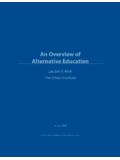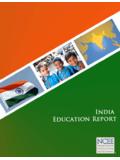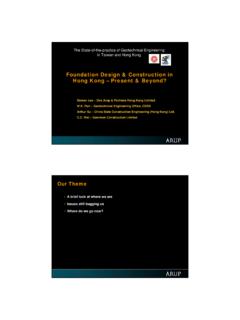Transcription of India Education Report - NCEE
1 National Center on Education and the Economy, 2005 India Education Profile Gretchen Rhines Cheney with support from Betsy Brown Ruzzi and Karthik Muralidharan National Center on Education and the Economy New Commission on the Skills of the American Workforce November 2005 National Center on Education and the Economy, 2005 2 India Education Profile India , with more than a billion residents, has the second largest Education system in the world (after China).
2 Experts estimate that 32 percent of its current population is under the age of But counter to the image of India as a youthful engine of economic growth where many urban-based citizens work in some of the best technology-centered jobs in the world, males in India complete just years of schooling on average, females just And for the small proportion who do persist through primary and secondary schooling, the quality of instruction varies widely, depending on the region of the country and whether one is enrolled in a State-supported public school or a fee-based private school.
3 Despite the highly inefficient delivery of public services, high levels of teacher absenteeism and non-teaching activity, many Indian students remain motivated to succeed on the college entrance exams. The high level of competition for entry into the Indian Institutes of Technology, the Indian Institutes of Management and other top institutions is enough to spur millions of students to achieve at remarkably high levels, particularly in the areas of science and mathematics. The increased demand for higher Education is not currently being met: only ten percent of the age cohort is actually enrolled in higher Education .
4 But in a country with such a large population, ten percent enrollment amounts to 9 million students, resulting in million new college graduates a year. These numbers driven by the private sector opportunities abroad, and increasingly, back in India , will continue to ensure India s prowess in delivering high-quality technical manpower. Historically, Indian Education has been elitist. Traditional Hindu Education was tailored to the needs of Brahmin3 boys who were taught to read and write by a Brahmin teacher.
5 Under British rule from the 1700s until 1947, India s Education policies reinforced the pre-existing elitist tendencies, tying entrance and advancement in government service to academic Education . Colonial rule contributed to the legacy of an Education system geared to preserving the position of the more privileged classes. Education served as a "gatekeeper," permitting an avenue of upward mobility only to those with resources. Post-primary Education has traditionally catered to the interests of the higher and upwardly mobile castes.
6 In the nineteenth century, post-primary students were disproportionately Brahmins; their traditional concern with learning gave them an advantage under British Education policies. By the early twentieth century, several other castes realized the advantages of Education as a passport to political power and managed to acquire formal learning. But even today, the vast majority of students making it through middle school to high school continue to be from high-level castes and middle- to upper class families living in urban areas.
7 1 The World Fact Book, CIA. 2004 estimate. 2 Public Report of Basic Education , 1999 3 Brahmin is the highest caste group in India , traditionally made up of priests, philosophers, scholars, and religious leaders. National Center on Education and the Economy, 2005 3 This historical barrier coupled with the post-independence focus of the Education system on tertiary Education more than primary Education (relative to the number of students in each category), makes it unsurprising that India has the largest number of illiterate people in the world.
8 According to the 2001 Census, more than one out of every three Indian citizens (and 42 percent of adults) is illiterate. The gap between male and female illiteracy, while still a challenge, is decreasing: 25 percent illiteracy for males and 46 percent for females. There is also a wide discrepancy in the literacy rates of different At one end, the state of Kerala has achieved 90 percent literacy, while on the other end, the state of Bihar has only 39 While the government has increased its focus on primary Education , the highly inefficient state of public service delivery in Education , with high teacher absence6 and low teaching activity even when teachers are present, is likely to keep learning levels low for the foreseeable future.
9 India has more languages than any other country - fifteen main languages and hundreds of other languages and dialects. Hindi is the national language and the primary tongue of 30 percent of the people. The other main languages are Bengali, Urdu, Punjabi, Gujarati, Tamil and Telegu. And English is ubiquitous in India , a former British colony. While not classified as one of the fifteen national languages, English is certainly important in higher Education , upward social mobility, and has played a key role in establishing India as an economic power globally.
10 In 1997 an India Today survey suggested that about a third of the population had the ability to carry on a conversation in This was an amazing increase over the estimates of the 1980s, when only about four to five percent of the population were thought to use the language. And given the steady increase in English learning since 1997 in secondary schools and among the upwardly mobile, it is estimated that there are 350 million English-speaking Indians today. This is more than the combined English-speaking populations of Britain and the India has been able to capitalize on its large numbers of well-educated people, many of whom are skilled in the English language, to become a major exporter of software services and software workers.
















